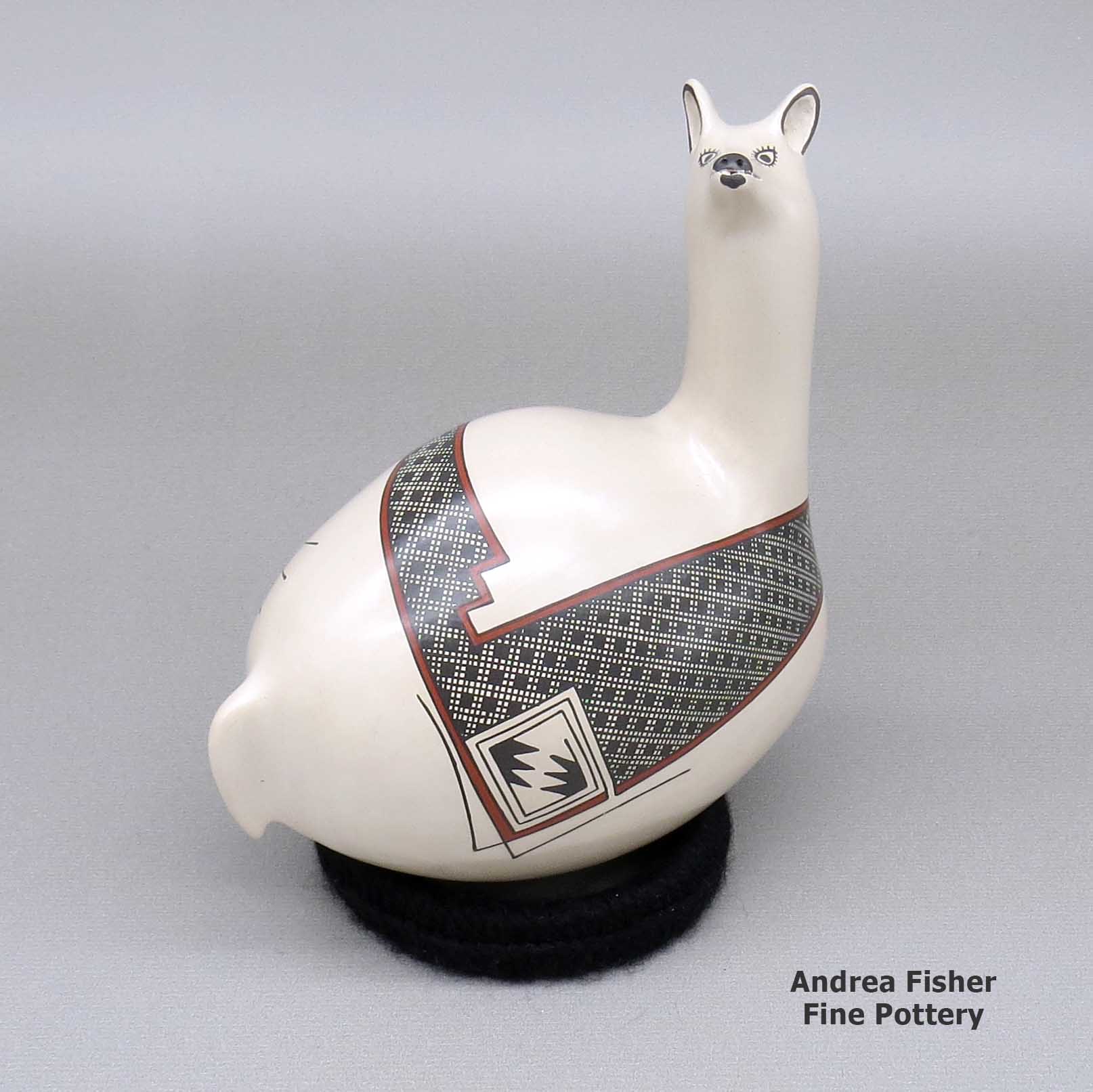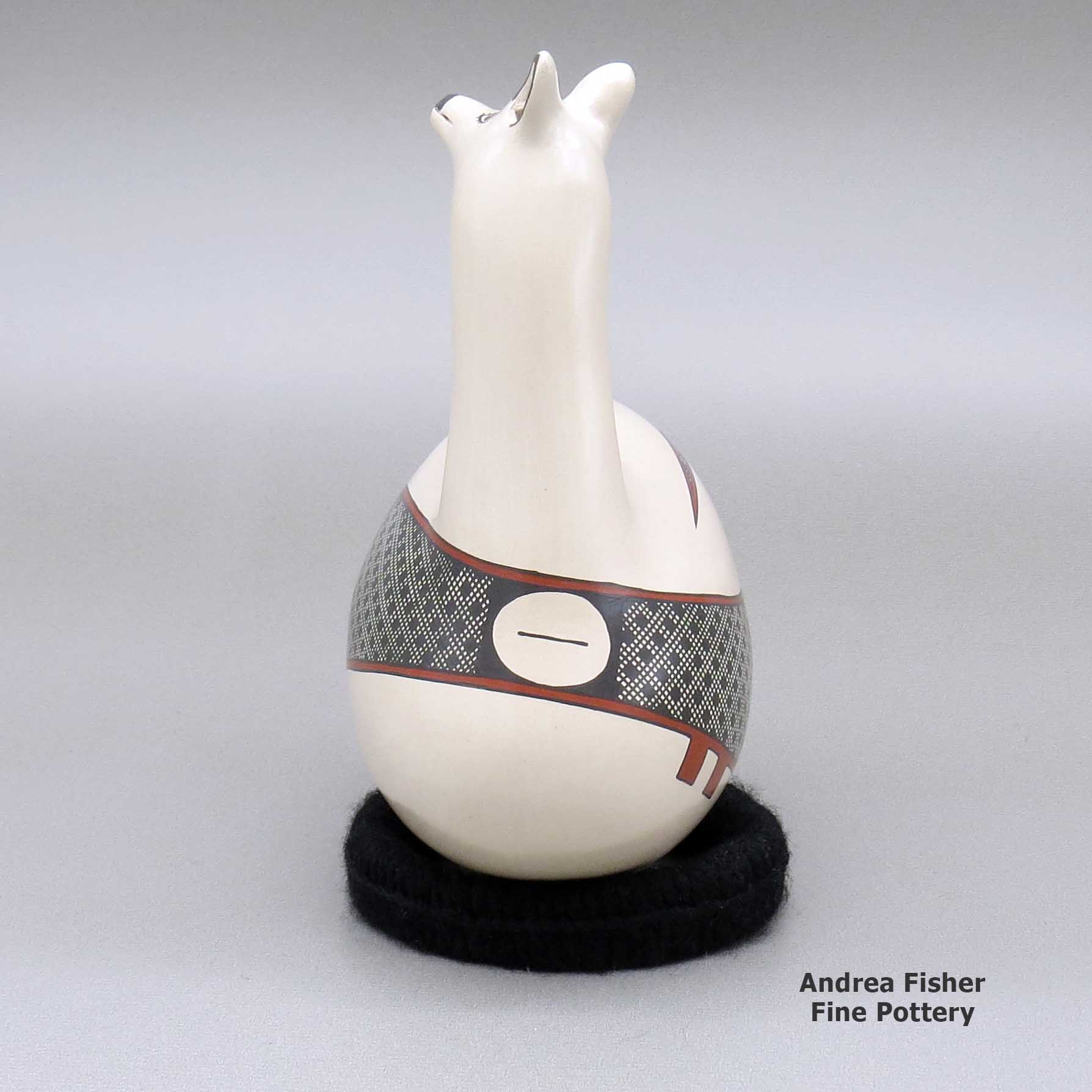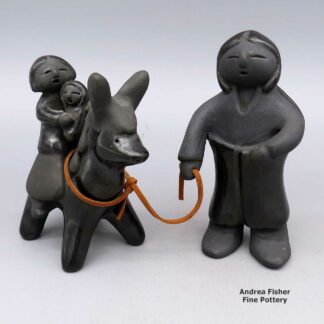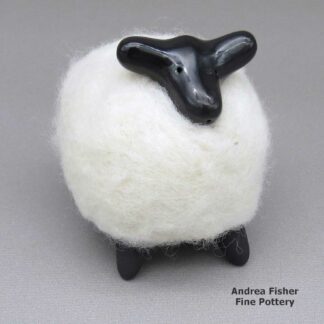| Dimensions | 4.75 × 2.75 × 5.75 in |
|---|---|
| Measurement | Measurement includes stand |
| Condition of Piece | Excellent |
| Date Born | 2023 |
| Signature | Gerardo Tena y Norma Hdez |
Gerardo Tena, zzcg3c213m8, Llama effigy with a geometric design
$450.00
A polychrome llama effigy jar decorated with a geometric design
In stock
- Product Info
- About the Artist
- Home Village
- Design Source
- About the Shape
- About the Design
- Family Tree
Brand
Tena, Gerardo
One of the earliest potters in Mata Ortiz, Felix taught Gerardo how to work with clay and make jars, bowls and intricate effigies and figures. Felix also taught him how to fire his pieces. Gerardo's mother, Sofia Sandoval de Tena, taught him how to paint.
Gerardo often collaborates with his wife, Norma Hernandez de Tena, in the making of zoomorphic figurines.
Awards Gerardo has earned
- At the annual Concurso Ceramica de Mata Ortiz: Zomorfas (zoomorphic or animal) Category: First Place in 1998, 1999, 2002, 2004, 2008 and 2011, Second Place in 2000 and Third Place in 2007
- Diseños Mimbres (painted Paquimé Revival designs) Category: Third Place in 1999. In 1998 he earned an Honorable Mention in Miniatures, Third Place in 2006 and a First Place in 2011
- Nuevos Diseños (New Designs) Category he earned First Place in 2006 with "The Quails," Third Place in 2009 with "Quadrito," a square piece made to hang on the wall, and Third Place in 2007 with "The Armadillo."
About Mata Ortiz and Casas Grandes
Mata Ortiz is a small settlement inside the bounds of the Casas Grandes municipality, very near the site of Paquimé. The fortunes of the town have gone up and down over the years with a real economic slump happening after the local railroad repair yard was relocated to Nuevo Casas Grandes in the early 1960s. It was a village with a past and little future.
A problem around the ancient sites has been the looting of ancient pottery. From the 1950s on, someone could dig up an old pot, clean it up a bit and sell it to an American dealer (and those were everywhere) for more money than they'd make in a month with a regular job. And there's always been a shortage of regular jobs.
Many of the earliest potters in Mata Ortiz began learning to make pots when it started getting harder to find true ancient pots. So their first experiments turned out crude pottery but with a little work, their pots could be "antiqued" enough to pass muster as being ancient. Over a few years each modern potter got better and better until finally, their work could hardly be distinguished from the truly ancient. Then the Mexican Antiquities Act was passed and terror struck: because the old and the new could not be differentiated, potters were having all their property seized and their families put out of their homes because of "antiqued" pottery they made just yesterday. Things had to change almost overnight and several potters destroyed large amounts of their own inventory because it looked "antique." Then they went about rebooting the process and the product in Mata Ortiz.
For more info:
Mata Ortiz pottery at Wikipedia
Mata Ortiz at Wikipedia
Casas Grandes at Wikipedia
Contemporary Pottery
The term "contemporary" has several possible shadings in reference to Southwestern pottery. At some pueblos, it's more an indicator of a modern style of carving or etching than anything else. At San Felipe it refers to almost anything newly made there as they have almost no prehistoric templates to work from. At Jemez the situation resolved to where what makes a piece uniquely "Jemez" is the clay. Any designs on that clay can be said to be "contemporary."
About Effigies
An effigy is a sculpture or model of an animal or person. Effigies have a long history among southwestern Native Americans. Effigies include everything from pottery that explicitly resembles a human or an actual animal to pottery that only references a part or parts of a human or an animal in its shape to creations of creatures that are absolutely wild and whimsical.
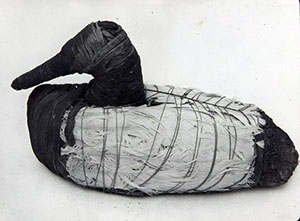
In Nevada, near the Humboldt Sink (where the Humboldt River disappears into the desert sands), a group of guano miners working in Lovelock Cave in 1911 exposed some ancient artifacts while they were digging. Shortly after the miners left, some archaeologists arrived and started poking around and digging, too. They weren't much better educated in the practices of archaeological digging than the guano miners were but they did save almost everything they found. It was more than a decade after those archaeologists investigated the cave that other archaeologists dug a bit deeper in the back of the cave and found a bundle of eleven duck decoys, all woven of local reeds more than 2,300 years ago. Some were painted, some were decorated with feathers, some weren't finished yet.
Effigies have been found in Mayan ruins, Aztec ruins, the ruins of Teotihuacan, the ruins near Valdivia in Ecuador, the ruins of the pyramid-building cultures in Peru and ruins near the Caribbean coast in Colombia. There were many effigies found in the ruins of Paquimé, too.
Photo of the duck decoy courtesy of the Autry Museum, CCA-by-SA 3.0 License.
About Geometric Designs
"Geometric design" is a catch-all term. Yes, we use it to denote some kind of geometric design but that can include everything from symbols, icons and designs from ancient rock art to lace and calico patterns imported by early European pioneers to geometric patterns from digital computer art. In some pueblos, the symbols and patterns denoting mountains, forest, wildlife, birds and other elements sometimes look more like computer art that has little-to-no resemblance to what we have been told they symbolize. Some are built-up layers of patterns, too, each with its own meaning.
"Checkerboard" is a geometric design but a simple black-and-white checkerboard can be interpreted as clouds or stars in the sky, a stormy night, falling rain or snow, corn in the field, kernels of corn on the cob and a host of other things. It all depends on the context it is used in, and it can have several meanings in that context at the same time. Depending on how the colored squares are filled in, various basket weave patterns can easily be made, too.
"Cuadrillos" is a term from Mata Ortiz. It denotes a checkerboard-like design using tiny squares filled in with paints to construct larger patterns.
"Kiva step" is a stepped geometric design pattern denoting a path into the spiritual dimension of the kiva. "Spiral mesa" is a similar pattern, although easily interpreted with other meanings, too. The Dineh have a similar "cloud terrace" pattern.
That said, "geometric designs" proliferated on Puebloan pottery after the Spanish, Mexican and American settlers arrived with their European-made (or influenced) fabrics and ceramics. The newcomers' dinner dishes and printed fabrics contributed much material to the pueblo potters design palette, so much and for so long that many of those imported designs and patterns are considered "traditional" now.
Ortiz Family and Teaching Tree - Mata Ortiz
Disclaimer: This "family and teaching tree" is a best effort on our part to determine who the potters are in this grouping and arrange them in a generational order/order of influence. Complicating this for Mata Ortiz is that everyone essentially teaches everyone else (including the neighbors), so it's hard to get a real lineage of family/teaching. The general information available is scant. This diagram is subject to change as we get better info.
- Ortiz Family
- Ermeterio Ortiz (d. 1998)
- Manuel and Benita Reyes
- Manuel Reyes Jr.
- Yolanda Reyes
- Martin Rios
- Mari Rios (niece)
- Porfilio Pilo Mora
- Lupita Mora
- Manuel Mora
- Jorge Cordero Palacios
- Jorge Cordero Luruena
- Sabino Caby Villalba & Bacilia Hernandez de Villalba
Others who learned from him:
- Adriana Villalba de Andrew
- Andres Villalba (Sabino's father) (1947-2001)
- Elias Pena (learned from Andres)
- Carlos Villalba
- José Andres Villalba
- Maria de Lourdes Villalba
- Manuel and Benita Reyes
- Felix Ortiz & Otila Sandoval
- Macario Ortiz
- Raquel Ortiz & Cesar Navarette
- Eli Navarette
- Roberto Beto Tena & Sofia Sandoval de Tena
- Adolfo Fito Tena
- Gerardo Tena & Norma Hernandez de Tena
- Gerardo Tena Jr.
- Mariela Tena
- Melissa Tena
- Antonia Tena de Mora
- Bonifacia Mora
- Laulo Mora
- Manuel Mora
- Nena Mora
- Rosa Mora
- Teodora Ortiz & Reynaldo Pedregon
- Enrique Pedregon Ortiz
